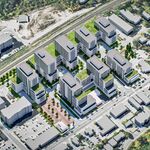Lessons from London: For building transit, there’s no avoiding taxes
Read More: http://www.thestar.com/news/gta/201...uilding_transit_theres_no_avoiding_taxes.html
.....
When we found out that Martin Buck, the commercial director of Crossrail, was in town for a convention, we at the Star invited him in to explain how his line might — and might not — compare to the one Tory now has a mandate to move forward on.
- Crossrail will represent a 10 per cent increase in capacity to what Buck calls a “mature” transit network that already includes 402 kilometres of Underground subway track and 125 kilometres of commuter rail on its “Overground” network, a system that is at or near capacity. Which means that at launch, the trains will run every 2.5 minutes in each direction, versus every 15 minutes in Tory’s SmartTrack plan.
- The vehicles will also have monstrously high capacity. Buck told us of the need to construct stations that cost almost $1 billion Canadian because they’ll be 250 metres long to accommodate the trains. Tory, by contrast, is proposing SmartTrack use a kind of train smaller than existing GO trains and smaller than our subway trains.
- Buck says the plan for Crossrail emerged not in a political campaign, but in studies commissioned and passed along since the 1970s or 1980s by transit planners. The project finally came up for formal proposal in the form of legislation in 2005, when it was widely embraced by local politicians, including the then-mayor of London, Ken Livingstone, and then his successor, Boris Johnson. It is projected to be finished in 2018 — 13 years after that initial formal process was begun and decades after the initial rough plans were drawn up.
- But it is in the use of what Buck calls “innovative” financing — in contrast to Tory’s proposal — that we might most hope to learn from London’s example. Of the £14.8-billion ($26.8 billion Cdn) budget, a little less than half is being paid by the city of London. The city is raising its contribution in a few ways. Buck told us the business case to do so came in part from the potential £5 billion in land value uplift they project could come from the project and the total of £40 billion-plus in economic benefits the line is expected to deliver.
- In borrowing with the expectation of future economic value increases, this sounds a bit like Tory’s Tax Increment Financing plan. But that’s where the comparison stops. Because in London they see the projected economic improvements as a justification to raise taxes now, not as a source of magical funding. In 2010, London began levying a 2 per cent annual premium on the property taxes paid by businesses across the Greater London Area, with the revenue earmarked for Crossrail. This measure, which had vocal support from the London First business lobby group, will generate about £4 billion.
- In addition, the mayor will levy a one-time infrastructure fee on various neighbourhood ratepayers (residences and businesses alike) of between £20 and £100 when the project is completed, adding a further £300 million. The city is borrowing against the future earnings from both of these sources of revenue, so that they have the capital upfront to spend on construction.
- In contrast, the people and businesses of London are already paying increased taxes for the Crossrail and will continue to do so in the future through tax increases already announced. That, unsurprisingly, is very similar to how we in Toronto wound up agreeing to pay for the Scarborough subway extension, with a 1.6 per cent property tax increase already being phased in. It is the responsible way to pay for transit.
.....




